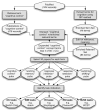A collaborative knowledge base for cognitive phenomics
- PMID: 18180765
- PMCID: PMC3952067
- DOI: 10.1038/sj.mp.4002124
A collaborative knowledge base for cognitive phenomics
Abstract
The human genome project has stimulated development of impressive repositories of biological knowledge at the genomic level and new knowledge bases are rapidly being developed in a 'bottom-up' fashion. In contrast, higher-level phenomics knowledge bases are underdeveloped, particularly with respect to the complex neuropsychiatric syndrome, symptom, cognitive, and neural systems phenotypes widely acknowledged as critical to advance molecular psychiatry research. This gap limits informatics strategies that could improve both the mining and representation of relevant knowledge, and help prioritize phenotypes for new research. Most existing structured knowledge bases also engage a limited set of contributors, and thus fail to leverage recent developments in social collaborative knowledge-building. We developed a collaborative annotation database to enable representation and sharing of empirical information about phenotypes important to neuropsychiatric research (www.Phenowiki.org). As a proof of concept, we focused on findings relevant to 'cognitive control', a neurocognitive construct considered important to multiple neuropsychiatric syndromes. Currently this knowledge base tabulates empirical findings about heritabilities and measurement properties of specific cognitive task and rating scale indicators (n=449 observations). It is hoped that this new open resource can serve as a starting point that enables broadly collaborative knowledge-building, and help investigators select and prioritize endophenotypes for translational research.
Figures




References
Publication types
MeSH terms
Grants and funding
LinkOut - more resources
Full Text Sources
Research Materials
Miscellaneous

